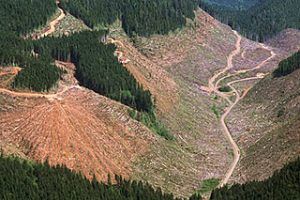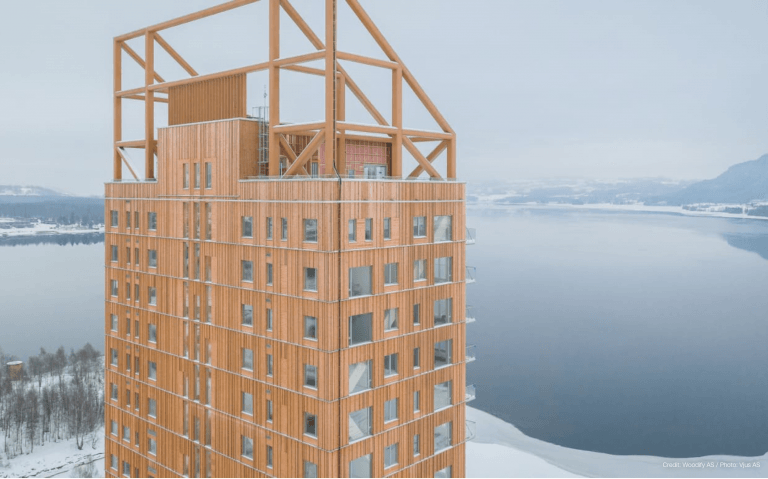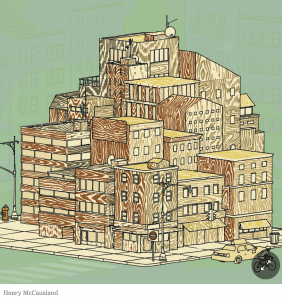To Save Our Climate We Need Taller Trees Not Taller Wooden Buildings
John Talberth • Feb 14, 2020

To many of us working at the intersection of forest conservation and climate stability recent opinions and news coverage of proposals to fill our cities with tall wooden buildings presents not a stirring vision of sustainability but a nightmarish scenario of a land base increasingly scarred by clearcuts, logging roads and small diameter tree plantations at a time when climate science insists that reestablishing natural forests and letting them grow much bigger and older is one of humanity’s last best hopes to keep climate change from accelerating out of control. To save our climate we need taller trees not taller wooden buildings.
There are two key reasons for this. The first has to do with the carbon cycle and how managing forestlands for tall trees vs. tall wood buildings affects atmospheric concentrations of CO2. Natural forests, allowed to grow big and tall, accumulate carbon for centuries. While some carbon is emitted through decay of dead trees and sporadic wildfires, much more is caught than released and so carbon is taken out of the atmosphere and built up on the land for a very long time. As such, using proforestation – letting trees attain their maximum size – as well as other climate smart practices to replenish carbon stocks on lands where it has been depleted by logging will help humanity bend the curve on CO2 concentrations in the atmosphere back towards the scientific safe zone of less than 350 parts per million.

In contrast, boosting production for massive new wood for buildings takes CO2 concentrations in the other direction. Wood buildings release carbon, they don’t store it. Wood is half carbon by weight and once cut off the stump is emitted into the atmosphere at rates that are well known but vary with species and end use. More wood products in use means more wood products emissions. It also means fewer trees on the land absorbing carbon because the short rotation timber plantations from which mass timber products are sourced are clearcut so often that nearly half of the landscape at any one time is a carbon sequestration dead zone. In particular, net ecosystem productivity, a measure of carbon sequestration, is negative for many years after clearcutting because emissions from the decay of logging debris and exposed soils outweighs any carbon captured by newly planted seedlings. Higher rates of clearcutting needed to feed demand for new wood buildings means expansion of the area occupied by these carbon sequestration dead zones.
Increased emissions and diminished carbon sequestration capacity – these two effects make conventional wood production very carbon intensive. For every ton of carbon stored in wood buildings many more are emitted along the way. In two separate assessments in Oregon, greenhouse gas emissions from logging and wood products were found to be the largest source of greenhouse gas emissions in the state, though untallied under current GHG accounting protocols. A recent analysis in North Carolina suggests that logging and wood products production there is likely the third largest source. The carbon intensities suggested by this research should be a cause for concern for anyone promoting the idea of more logging and tall wooden buildings as climate solutions. Life Cycle Analysis (LCA) is the gold standard for comparing the relative carbon intensities of wood versus substitutes for various uses, and one recent analysis that included emissions associated with soil carbon loss and conversion of native forests into tree plantations found wood-based buildings to have a cradle to grave carbon footprint six percent higher than concrete buildings. Advances in concrete technologies that reduce its carbon footprint show promise in tipping the scales even further.

The second key reason why big tall trees are preferable to tall wooden buildings has to do with the ability of our forest dependent communities to adapt to climate change. An alarming conclusion from many scientific studies approaching the issue from many directions is that landscapes dominated by clearcuts and corporate tree plantations are far less resilient to the effects of climate change. They are more susceptible to wildfires, flooding, insects, disease, wind damage, landslides and harmful algae blooms than the natural forests they’ve replaced. These stressors are already on the rise due to climate change – timber plantations make the effects so much worse. For example, in fire prone regions of the West, these timber plantations burn hotter and faster than natural forests. They produce far less water in the dry season and the waters that trickles out are more vulnerable to harmful algae blooms (HABs) because they’re hotter and laced with a cocktail of chemicals and fertilizers that help boost seedling growth but fuel HAB growth as well. Hurricanes have a field day in monoculture tree plantations while real forests with a diversity of ages and tree sizes survive more intact.
In addition, the conversion of structurally diverse forests into monoculture tree plantations is helping to drive many species towards extinction. In the Pacific Northwest, the expansion of industrial tree plantations puts over 1,000 species that need real forests to survive at risk. Northern spotted owl populations are declining at a rate of 4% per year, in part due to continuing habitat loss. North America has lost over a third of its birds since 1970, and loss of natural forests is a key factor.
Clearly, we need to reduce logging pressures on the land and not increase demand with wooden skyscrapers and cross laminated timber – a product based on small diameter plantation trees. Instead, we need a rapid transition to climate smart practices that can provide steady supplies of high-quality, large diameter wood to meet demand while simultaneously achieving four key climate objectives: reduced emissions, increased sequestration, increased carbon storage on the land and enhanced climate resilience. In addition to proforestation, extended rotations and various forms of selective harvesting can meet this test.
Policy makers have a rich portfolio of options to scale these practices up and phase out industrial tree plantations. Given their unique role on the landscape (i.e. the only lands where the public has any rights) forestlands managed by federal, state, and local public agencies should be set aside as forest carbon reserves and no longer managed for commercial logging. Massachusetts is considering a bill to do that on state-owned lands, and the Sierra Club and others are mounting a campaign to establish a forest carbon trust on federal public lands.
On private lands, market-based strategies can help penalize bad practices and reward the good. In Oregon, a forest carbon tax and reward bill was drafted for consideration in 2017 to do just this. Carbon emissions from timber plantations would be taxed at the social cost of carbon to capitalize a forest carbon incentives fund to help offset the cost of climate smart practices by responsible forestland owners as they manage their lands for carbon storage, timber, recreation, wildlife, fish and many other ecosystem goods and services. Thousands of new jobs in the woods would be created because climate smart practices are far more labor intensive than the highly mechanized techniques used in timber plantations.
Rescinding and redirecting harmful logging subsidies is another market-based strategy that holds great promise. Every year, federal, state and local public agencies grant logging corporations a wide spectrum of subsidies that take the form of below cost timber from public lands, tax exemptions, reduced tax rates and a number of direct services and expenditures such as unreimbursed firefighting costs, grants, and technical assistance. Below cost timber sales on federal public lands alone cost taxpayers nearly $2 billion a year. Handing out these subsidies for free is no longer an option in a climate constrained world. At the very least, they need to be conditioned on good practices on the land. A bill to do this was introduced in Oregon in 2019. It would make receipt of over $300 million a year in various tax breaks contingent upon the land being covered in healthy forests and not clearcuts, logging roads, or timber plantations.
We agree wholeheartedly with Lowenstein et al. when they said in a New York Times opinion piece last fall, “Trees are some of our best allies in solving the climate crisis.” But to do so, they need to be allowed to grow to maturity wherever possible. Policies to do this have been crafted and introduced. Decision makers need to embrace these rather than the false solutions offered by wooden skyscrapers and cross laminated timber.
Share Post
All Rights Reserved | Center for Sustainable Economy


